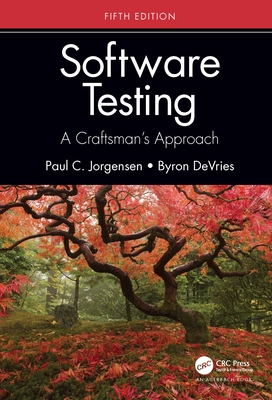Measuring the Software Process
暫譯: 測量軟體流程
William A. Florac, Anita D. Carleton
- 出版商: Addison Wesley
- 出版日期: 1999-07-25
- 售價: $2,310
- 貴賓價: 9.5 折 $2,195
- 語言: 英文
- 頁數: 272
- 裝訂: Hardcover
- ISBN: 0201604442
- ISBN-13: 9780201604443
-
相關分類:
專案管理 PM
立即出貨 (庫存 < 4)
買這商品的人也買了...
-
 IBM 80X86 MASM 6.X 組合語言實務
IBM 80X86 MASM 6.X 組合語言實務$450$383 -
 管理資訊系統 (Management Information Systems, 6/e)
管理資訊系統 (Management Information Systems, 6/e)$720$706 -
 軟體加密原理與應用
軟體加密原理與應用$450$405 -
 $1,984Managing the Software Process
$1,984Managing the Software Process -
 AutoCAD 2006 實力養成暨評量
AutoCAD 2006 實力養成暨評量$350$277 -
 深入淺出 Java 程式設計, 2/e (Head First Java, 2/e)
深入淺出 Java 程式設計, 2/e (Head First Java, 2/e)$880$695 -
 作業系統原理 (Silberschatz: Operating System Principles, 7/e)
作業系統原理 (Silberschatz: Operating System Principles, 7/e)$780$741 -
 鳥哥的 Linux 私房菜基礎學習篇, 2/e
鳥哥的 Linux 私房菜基礎學習篇, 2/e$780$663 -
 ASP.NET 2.0 深度剖析範例集
ASP.NET 2.0 深度剖析範例集$650$507 -
 SQL 語法範例辭典
SQL 語法範例辭典$550$468 -
 專案管理黑皮書
專案管理黑皮書$270$213 -
 Visual C# 2005 建構資訊系統實戰經典教本
Visual C# 2005 建構資訊系統實戰經典教本$650$507 -
 Dreamweaver 搞不定的網頁設計效果:CSS 關鍵救援密碼
Dreamweaver 搞不定的網頁設計效果:CSS 關鍵救援密碼$520$442 -
 Visual C# 2005 程式開發與介面設計秘訣
Visual C# 2005 程式開發與介面設計秘訣$750$593 -
 Ajax 實戰手冊 (Ajax in Action)
Ajax 實戰手冊 (Ajax in Action)$680$537 -
 Ajax 快速上手 (Head Rush Ajax)
Ajax 快速上手 (Head Rush Ajax)$780$616 -
 聖殿祭司的 ASP.NET 2.0 專家技術手冊─使用 C#
聖殿祭司的 ASP.NET 2.0 專家技術手冊─使用 C#$720$569 -
 Linux 核心詳解, 3/e (Understanding the Linux Kernel, 3/e)
Linux 核心詳解, 3/e (Understanding the Linux Kernel, 3/e)$1,200$948 -
 福爾摩沙報告2004
福爾摩沙報告2004$380$323 -
 C++ Primer, 4/e (中文版)
C++ Primer, 4/e (中文版)$990$891 -
 工程數學 (Advanced Engineering Mathematics, 3/e) (精華本)
工程數學 (Advanced Engineering Mathematics, 3/e) (精華本)$700$686 -
 現代嵌入式系統開發專案實務-菜鳥成長日誌與專案經理的私房菜
現代嵌入式系統開發專案實務-菜鳥成長日誌與專案經理的私房菜$600$480 -
 國際性 MCAS 認證 Word 2007 實務應用
國際性 MCAS 認證 Word 2007 實務應用$380$300 -
 TCP/IP Sockets in C: Practical Guide for Programmers, 2/e (Paperback)
TCP/IP Sockets in C: Practical Guide for Programmers, 2/e (Paperback)$1,400$1,330 -
 手繪圖解 Flash ActionScript 3.0
手繪圖解 Flash ActionScript 3.0$420$357
商品描述
Description
"While it is usually helpful to launch improvement programs, many such programs soon get bogged down in detail. They either address the wrong problems, or they keep beating on the same solutions, wondering why things don't improve. This is when you need an objective way to look at the problems. This is the time to get some data."
Watts S. Humphrey, from the ForewordThis book, drawing on work done at the Software Engineering Institute and other organizations, shows how to use measurements to manage and improve software processes. The authors explain specifically how quality characteristics of software products and processes can be quantified, plotted, and analyzed so the performance of software development activities can be predicted, controlled, and guided to achieve both business and technical goals. The measurement methods presented, based on the principles of statistical quality control, are illuminated by application examples taken from industry.
Although many of the methods discussed are applicable to individual projects, the book's primary focus is on the steps software development organizations can take toward broad-reaching, long-term success. The book particularly addresses the needs of software managers and practitioners who have already set up some kind of basic measurement process and are ready to take the next step by collecting and analyzing software data as a basis for making process decisions and predicting process performance.
Highlights of the book include:
- Insight into developing a clear framework for measuring process behavior
- Discussions of process performance, stability, compliance, capability, and improvement
- Explanations of what you want to measure (and why) and instructions on how to collect your data
- Step-by-step guidance on how to get started using statistical process control
If you have responsibilities for product quality or process performance and you are ready to use measurements to manage, control, and predict your software processes, this book will be an invaluable resource.
Table of Contents
Figures.
Foreword.
Preface.
Acknowledgments.
1. Managing and Measuring Process Behavior.
What Is a Software Process?
What Is Software Process Management?
The Role of Software Process Management.
Issues on the Road to Process Improvement.
The Need for Software Process Measurement.
Measuring Process Behavior.
A Framework for Process Behavior Measurement.
Summary.
2. Planning for Measurement.
Identifying Process Issues.
Selecting and Defining Measures.
Integrating Measures with the Software Process.
Summary.
3. Collecting the Data.
Principal Tasks.
The Specifics of Collecting Software Process Data.
Reviewing and Assessing Collected Data.
Retaining Data.
Tools for Understanding Your Data.
Summary.
4. Analyzing Process Behavior.
Separating Signals from Noise.
Evaluating Process Stability.
Control Chart Basics.
Summary.
5. Process Behavior Charts for Software Processes.
Control Charts for Variables or Discrete Data.
Control Charts for Attributes Data.
Summary.
6. More About Process Behavior Charts.
How Much Data Is Enough?
Anomalous Process Behavior Patterns.
Rational Sampling and Homogeneity of Subgroups.
Rational Subgrouping.
The Problem of Insufficient Granularity in Recorded Values.
Aggregation and Decomposition of Process Performance Data.
Summary.
7. Three Paths to Process Improvement.
Finding and Correcting Assignable Causes.
Process Capability.
Process Capability Analysis.
Improving the Process.
Improvement and Investment.
Summary.
8. Getting Started.
Ten Steps for Getting Started.
Frequently Asked Questions Regarding SPC.
Final Remarks.
Appendix A Control Chart Tables and Formulas.
Appendix B More About Analyzing Process Behavior.
Enumerative Versus Analytic Studies.
Three-Sigma Control Limits.
Central Limit Theorem and Role of the Normal Distribution.
Appendix C. Example Data and Calculations.
Appendix C.1.
Appendix C.2.
References.
Index.
商品描述(中文翻譯)
**描述**
「雖然啟動改善計畫通常是有幫助的,但許多此類計畫很快就會陷入細節之中。它們要麼解決錯誤的問題,要麼不斷重複相同的解決方案,卻不明白為什麼事情沒有改善。這時你需要一種客觀的方法來看待問題。這是收集一些數據的時候。」
——Watts S. Humphrey,摘自前言
本書基於在軟體工程研究所及其他組織的研究,展示如何利用測量來管理和改善軟體流程。作者具體解釋了如何量化、繪製和分析軟體產品和流程的質量特徵,以便預測、控制和引導軟體開發活動的表現,以達成商業和技術目標。所提出的測量方法基於統計質量控制的原則,並通過來自業界的應用範例進行說明。
雖然許多討論的方法適用於個別專案,但本書的主要重點是軟體開發組織可以採取的步驟,以實現廣泛的、長期的成功。本書特別針對已經建立某種基本測量流程的軟體管理者和從業人員,幫助他們通過收集和分析軟體數據來做出流程決策和預測流程表現。
本書的亮點包括:
- 開發清晰的流程行為測量框架的見解
- 討論流程表現、穩定性、合規性、能力和改善
- 解釋你想要測量的內容(及其原因)以及如何收集數據的指導
- 如何開始使用統計流程控制的逐步指導
如果你負責產品質量或流程表現,並且準備利用測量來管理、控制和預測你的軟體流程,本書將是你不可或缺的資源。
**目錄**
**圖表**
**前言**
**序言**
**致謝**
**1. 管理和測量流程行為**
什麼是軟體流程?
什麼是軟體流程管理?
軟體流程管理的角色。
流程改善之路上的問題。
軟體流程測量的必要性。
測量流程行為。
流程行為測量的框架。
摘要。
**2. 測量計畫**
識別流程問題。
選擇和定義測量。
將測量與軟體流程整合。
摘要。
**3. 收集數據**
主要任務。
收集軟體流程數據的具體細節。
審查和評估收集的數據。
保留數據。
理解數據的工具。
摘要。
**4. 分析流程行為**
分離信號與噪音。
評估流程穩定性。
控制圖基礎。
摘要。
**5. 軟體流程的流程行為圖**
變數或離散數據的控制圖。
屬性數據的控制圖。
摘要。
**6. 更多關於流程行為圖**
多少數據才算足夠?
異常流程行為模式。
合理取樣和子群的同質性。
合理子分組。
記錄值的粒度不足問題。
流程表現數據的聚合與分解。
摘要。
**7. 三條流程改善之路**
尋找和糾正可指派原因。
流程能力。
流程能力分析。
改善流程。
改善與投資。
摘要。
**8. 開始行動**
開始的十個步驟。
有關統計流程控制的常見問題。
最後的備註。
**附錄A 控制圖表和公式**
**附錄B 更多關於分析流程行為**


























